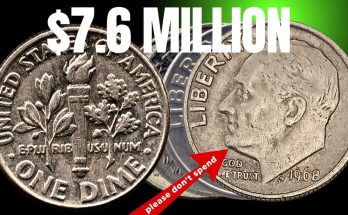Double Denomination Error Coins
When a coin that had already been struck by one pair of dies winds up back in the pressed and is struck by dies from another denomination, you get a so-called double denomination. One example of a double denomination might be a Roosevelt dime that ends up getting struck by Lincoln cent dies, or a Jefferson nickel that makes it way into the Washington quarter presses. Normally, the impression from the second strike is stronger than the first. Such errors are both rare and curious… How did the finished coin makes it way back into the presses? It’s possible, yes… But if that coin could talk, what would it say? Double denominations are among the most coveted rarities in this list of error coins. They are worth $250 and up.

Lamination Error Coins
Planchets that are missing some of their surface area due to dirt, grease, gas bubbles, or other maladies are called lamination errors. A lamination error may present a flake-like area of metal missing from the surface. Values depend on the size of the lamination error. While minor lamination errors may not be worth much at all, major laminations — especially those involving missing layers on clad coins — can be worth tons. Small lamination errors are worth $5 to $10. Major lamination errors are worth $25 to $50 or more.
Multiple Strike Error Coins
Sometimes, a coin will be struck multiple times on the press. This can result in that coin showing many impressions of the design. You might see two, three, or even more impressions of the design on the same coin. As you’ve learned, this is not the same as a doubled die, which is a variety caused in the die-making process, not the striking. Multiple strike errors are rare, and values depend on the coin and the number of strikes involved. Values for these coins are all over the map but usually start at around $50.

See current values for rare and common U.S. Mint error coins.
List 3: All Mint Error Coins By Denomination
Here are some of our other articles that discuss U.S. Mint common and rare error coins by denomination:





